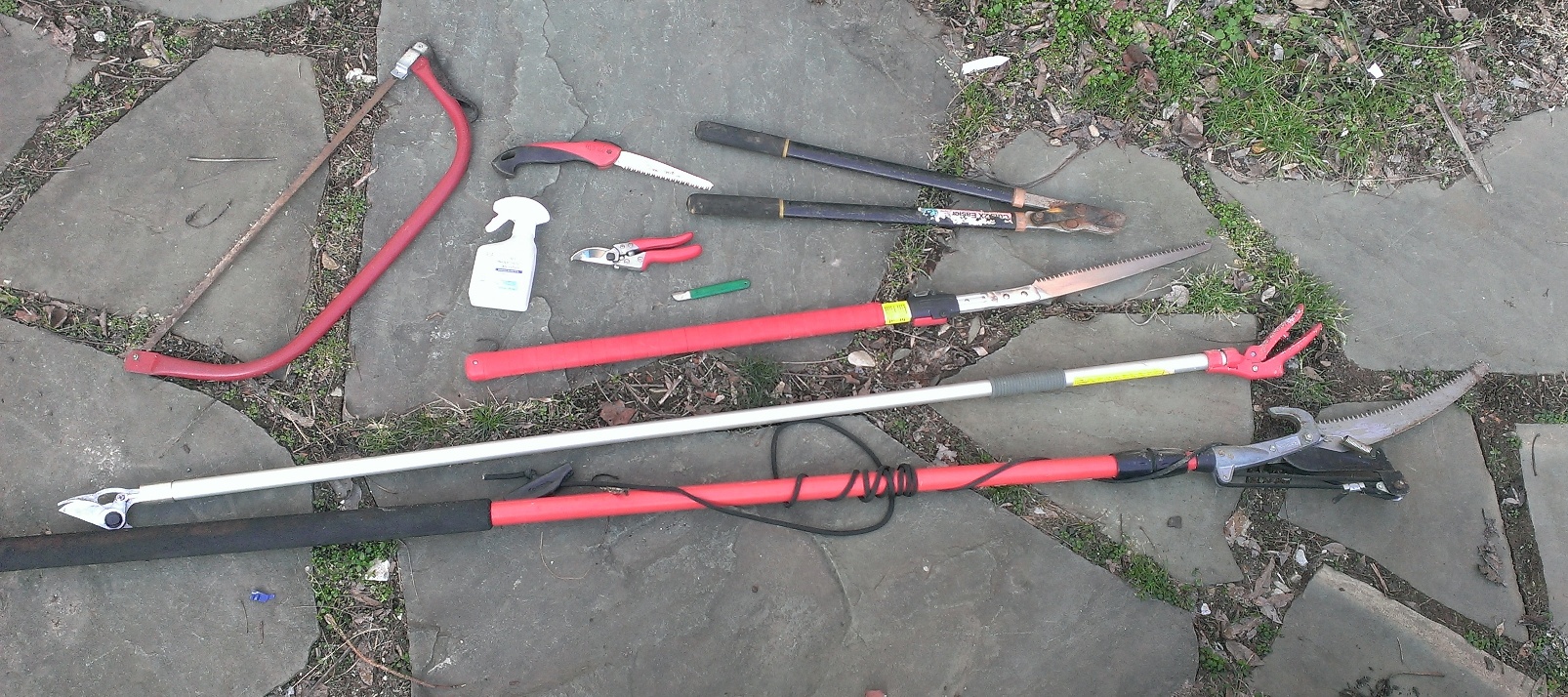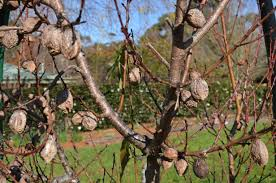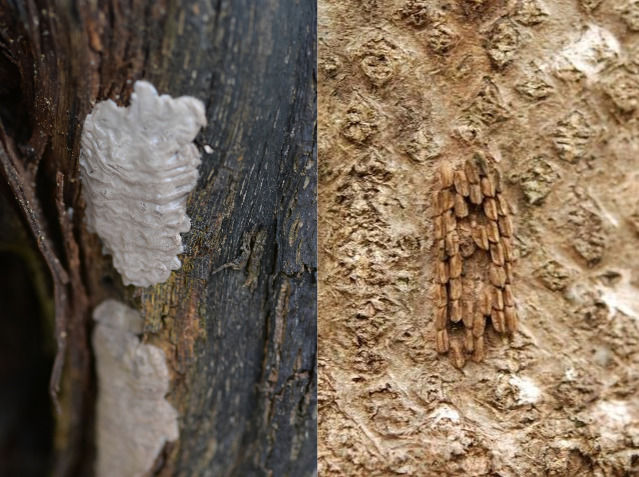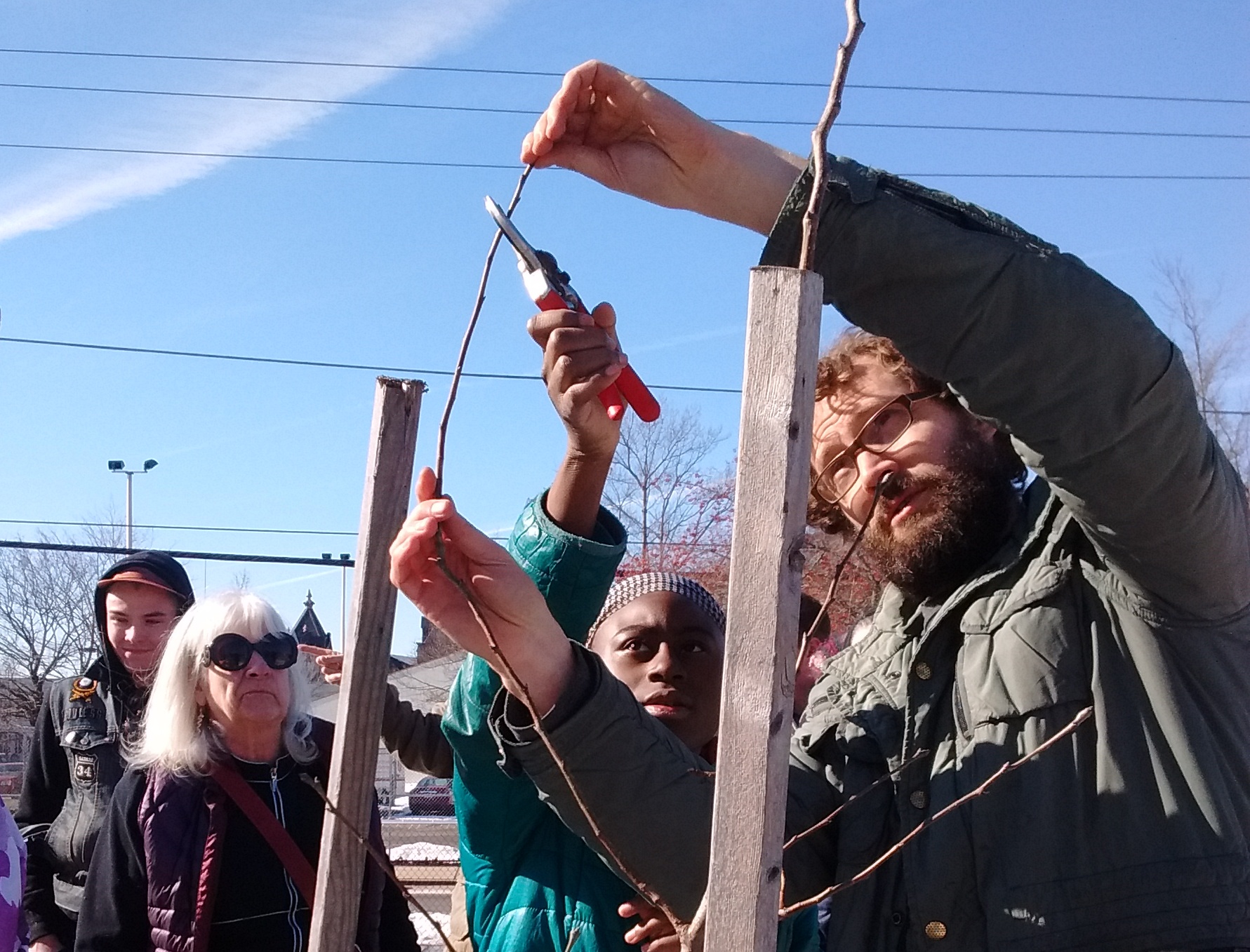POP TIPS: January Orchard Care Tasks
20 views
Skip to first unread message
Phil Forsyth
Jan 5, 2021, 8:08:35 AM1/5/21
to ph...@googlegroups.com
Dear Philly Orchardists,
Wishing everyone a more beautiful, bountiful new year!
Orchard care is a year round undertaking and January is the kickoff to pruning season in our climate. Please check out our new POP Monthly Orchard Task List for recommended maintenance activities to complete this month (the January list is also attached below).
Here is some more detail on some of the key tasks for January:
Orchard Tool Evaluation and Maintenance
With pruning season getting started, this is a good time to evaluate your tools and equipment. What's missing? What new tool might make your life easier? Order replacement saw blades for any that have dulled. Sharpen your pruning blades with a hand sharpener like this:

The basic orchard pruning toolset includes pole saw, pole pruner, loppers, handsaw, hand pruners, bowsaw, blade sharpener, and spray bottle of alcohol for sanitizing blades. Not pictured: tripod orchard ladder!
Winter pruning
The calendar and the cold tell us that it's time again for pruning fruit trees, berry bushes, and fruiting vines. It is important to prune most fruiting plants every winter, regardless of their age! Essentially everything except peaches are best pruned while dormant, between January and early March.

Annual pruning of almost all orchard plants is best accomplished during dormant season from January to mid March!
Here is a quick list of the reasons for annual pruning:
2. increase air circulation
3. improve quality, quantity & consistency of harvest
4. prevent infection and spread of disease
5. create good structure to support fruit
6. avoid breakage from poor branch angles
7. control size for easier harvest
8. ensure penetration of sprays
9. stimulate vegetative growth
You can find POP's full fruit tree pruning guide on our website:
And here's our guide to pruning berry bushes and fruiting vines:
POP staff expect to announce some winter pruning workshops in the next couple weeks, although attendance will be limited for safety.
A printable version of the POP Pruning Guide is also attached below.

Winter pruning season is also a good time to remove any remaining mummified fruit on trees, which can be a source of disease spores if left until spring.
Pest and Disease Monitoring & Identification

Spotted Lanternfly egg masses can be found on tree trunks and pretty much any other hard surfaces. Scrape them off and dispose of them.
Hope springs eternal- wishing all a brighter 2021!
Phil Forsyth, Co-Executive Director
Philadelphia Orchard Project
Pronouns: he/him
"65 community orchards, 1415 fruit trees, and growing!"
Phil Forsyth
Feb 3, 2021, 11:46:37 AM2/3/21
to ph...@googlegroups.com
Dear Philly Orchardists,
Hope you are enjoying all the snow! In addition to our February pruning workshops, POP has just posted our newly virtual POPCORE ecological orchardist workshop series for Tuesday evenings in March. We'll send more info out soon, but you can already register via our events page.
February is the heart of orchard pruning season in our climate- time to put on the snow boots and get out there! Please check out our new POP Monthly Orchard Task List for recommended maintenance activities to complete this month (the Feb/March list is also attached below).
Here is some more detail on some of the key tasks for February:
Orchard Tools & Supplies
Winter is a good time to consider what tools and supplies you may need for the upcoming season.
With pruning season getting started, this is a good time to evaluate your tools and equipment. What's missing? What new tool might make your life easier? Order replacement saw blades for any that have dulled. Sharpen your pruning blades with a hand sharpener like this:

The basic orchard pruning toolset includes pole saw, pole pruner, loppers, handsaw, hand pruners, bowsaw, blade sharpener, and spray bottle of alcohol for sanitizing blades. Not pictured: tripod orchard ladder!
This is also a good time to consider what other tools and supplies you may need for the upcoming orchard season. Gloves, hand tools, harvest equipment, organic sprays, etc? Wheelbarrow need a tune up? Shed re-organized? Get these done before you get too busy!
Winter pruning
There are still a couple spots open for our hands-on pruning workshops at Fairhill on 2/20 and Strawberry Mansion on 2/27. The virtual POPCORE 1 workshop on 3/2 will focus on pruning as well as an overview of ecological orchard care by season.
The calendar and the cold tell us that it's time again for pruning fruit trees, berry bushes, and fruiting vines. It is important to prune most fruiting plants every winter, regardless of their age! Essentially everything except peaches are best pruned while dormant, between January and early March.

Annual pruning of almost all orchard plants is best accomplished during dormant season from January to mid March!
Here is a quick list of the reasons for annual pruning:
2. increase air circulation
3. improve quality, quantity & consistency of harvest
4. prevent infection and spread of disease
5. create good structure to support fruit
6. avoid breakage from poor branch angles
7. control size for easier harvest
8. ensure penetration of sprays
9. stimulate vegetative growth
You can find POP's full fruit tree pruning guide on our website:
And here's our guide to pruning berry bushes and fruiting vines:
A printable version of the POP Pruning Guide is also attached below.

Winter pruning season is also a good time to remove any remaining mummified fruit on trees, which can be a source of disease spores if left until spring.
For POP community partner orchard sites, please reach out to your lead POP staff support to schedule a pruning session if you haven't already.
Pest and Disease Monitoring & Identification

Spotted Lanternfly egg masses can be found on tree trunks and pretty much any other hard surfaces. Scrape them off and dispose of them.
Dormant Oil Sprays

If you had challenges with aphids, scale, or other soft-bellied insects last year, consider a late winter application of dormant oil.
Wishing all a happy pruning season- hopefully we get a few warm days soon!
Phil Forsyth, Co-Executive Director
Philadelphia Orchard Project
Pronouns: he/him
"65 community orchards, 1472 fruit trees, and growing!"
Phil Forsyth
Jan 5, 2022, 11:40:26 AM1/5/22
to ph...@googlegroups.com
Dear Philly Orchardists,
Wishing everyone a beautiful, bountiful new year!
Orchard care is a year round undertaking and January is the kickoff to pruning season in our climate. Please check out our POP Monthly Orchard Task List for recommended maintenance activities to complete this month (the January list is also attached below). And register for this year's 4-part virtual POPCORE ecological orchard workshop series- to be held Tuesday evenings in March!
Here is some more detail on some of the key tasks for January:
Orchard Tool Evaluation and Maintenance
Join us for our upcoming workshop!
Thursday, January 13
7:00pm - 8:00pm
Tool Maintenance Virtual Workshop
Prepare for winter pruning by attending this virtual workshop where we will go over how to clean and sharpen pruning tools.
With pruning season getting started, this is a good time to evaluate your tools and equipment. What's missing? What new tool might make your life easier? Order replacement saw blades for any that have dulled. Sharpen your pruning blades with a hand sharpener like this:

The basic orchard pruning toolset includes pole saw, pole pruner, loppers, handsaw, hand pruners, bowsaw, blade sharpener, and spray bottle of alcohol for sanitizing blades. Not pictured: tripod orchard ladder!
Winter pruning
Sign up for our hands-on POPCORE pruning workshops at FNC Poplar Farm in North Philly on 2/5 and at Bartram's Garden in West Philly on 3/5. And stay tuned for our brand new fruit tree pruning video series to be released on POP's YouTube Channel in the next week or so!
The calendar and the cold tell us that it's time again for pruning fruit trees, berry bushes, and fruiting vines. It is important to prune most fruiting plants every winter, regardless of their age! Essentially everything except peaches are best pruned while dormant, between January and early March.

Annual pruning of almost all orchard plants is best accomplished during dormant season from January to mid March!
Here is a quick list of the reasons for annual pruning:
2. increase air circulation
3. improve quality, quantity & consistency of harvest
4. prevent infection and spread of disease
5. create good structure to support fruit
6. avoid breakage from poor branch angles
7. control size for easier harvest
8. ensure penetration of sprays
9. stimulate vegetative growth
You can find POP's full fruit tree pruning guide on our website:
And here's our guide to pruning berry bushes and fruiting vines:
A printable version of the POP Pruning Guide is also attached below.

Winter pruning season is also a good time to remove any remaining mummified fruit on trees, which can be a source of disease spores if left until spring.
Pest and Disease Monitoring & Identification

Spotted Lanternfly egg masses can be found on tree trunks and pretty much any other hard surfaces. Scrape them off and dispose of them.
Winter Protection for Figs and Pomegranates
Looks like we might possibly get some fig-damaging temperatures next week! Just a final reminder to wrap your figs if you haven't done so already.
Cold-sensitive orchard plants like figs and pomegranates benefit from some winter protection measures. These plants are able to take freezing temperatures without damage, but temperatures below 20 F can cause injury and can arrive at any point this time of year!
One of the simplest techniques for winter protection of young figs is to tie all the branches as close together as possible, surround the tree with some fencing, and fill the fencing with fall leaves, straw, or other available materials to provide insulation. There are plenty of fall leaves to be had right now- check your neighborhood on trash day if you don't have enough on site! If available, a tarp can also be placed on top. It is okay if some of the branches stick out. If we have a mild winter, those unprotected branches will be fine; if we get a harsh one, you'll simply cut them off in the spring after growth begins.

Fig surrounded by fencing and stuffed with fall leaves and straw as an insulator.
Another easy method for protection is to tie the branches together and surround the whole thing with an old carpet. Layers of burlap, row fabric, or even old bedsheets can also be used, although make sure to attach them securely so they don't blow away. For older, bigger figs, you may need to wrap individual trunks/branches with this kind of insulation to protect them.
See here for our full article on growing figs in cold climates:
Hope springs eternal- wishing all a bright 2022!
Phil Forsyth, Co-Executive Director
Philadelphia Orchard Project
Pronouns: he/him
Reply all
Reply to author
Forward
0 new messages
